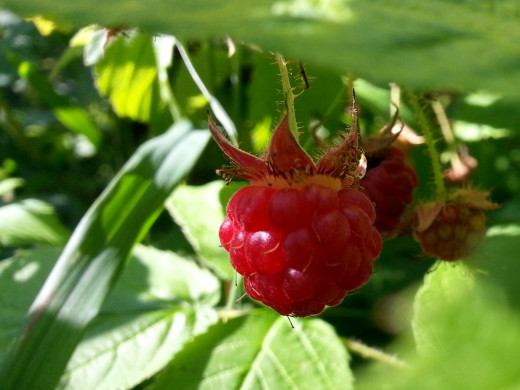Medicinal Uses for Raspberries
Raspberries are not only delicious and nutritious, but have medicinal value as well.

Red raspberry is a widely eaten, tasty, sweet berry. The raspberry fruit, leaves, and roots have also been used as medicine for centuries. Today, red raspberry leaf and fruit are still used as medicine by neo-herbalists.
Raspberry Fruit As Medicine
One cup of raspberries per day will provide 88% of your daily requirement for vitamin C. Vitamin C assists in the prevention of eye diseases including cataracts and glaucoma. Vitamin C improves circulation by strengthening capillaries and making them more elastic. This ability helps prevent nosebleeds, excessive menstrual bleeding, and might even help prevent strokes.
Eating raspberries aids the body in detoxification and prevents degenerative diseases. A cup of raspberries every day will helps individuals lose weight, reduce blood pressure, provide capillary resistance in developing cardiovascular disease, prevent allergies, prevent infections, and can also improve iron absorption.
Anthocyanins which give the raspberries their red or purple color protect eye capillaries and maintain heart health.
Eating a cup of raspberries every day is also beneficial for anyone under stress. It reduces the inflammation of chronic diseases such as arthritis. It can even help prevent some damage caused from heavy smoking.
Raspberry contains sufficient amounts of potassium, calcium, and magnesium. It is also rich in the trace minerals manganese, zinc, iron, and chromium as well as vitamins B and C. This helps prevent leg cramps, and prevents insomnia during pregnancy.
Red raspberry fruit is eaten, processed into jams, and dried into fruit leathers.
Eating Raspberries to Fight Obesity
Studies are currently being done concerning using raspberries in obesity management and type-two diabetes. Two compounds are of special interest--raspberry ketone (also called rheosmin) and a type of flavonoid called tiliroside.
A compound that occurs naturally in raspberries, raspberry ketone is not exclusive to the raspberry. It also can be found in a wide variety of other plants such as Turkish rhubarb. It can also be found in the leaves of maple, larch, yew, maple, and some pine trees.
Raspberry ketones found in raspberries increase metabolism in our fat cells by increasing enzyme activity, oxygen consumption, and heat production. This boosts fat metabolism so that we are less likely to deposit fat into our fat cells. It provides access to the fat that we have already stored. In the process, the number of inflammation messages is created in our fat molecules and are less likely to have the inflammation that accompanies obesity. The ketones also decrease the fat-digesting enzyme--pancreatic lipase produced in our pancreas causing us to absorb less fat. This is another plus when fighting obesity.
The other compound--tilirosside is a flavonoid that is found in many of the rose family plants. These plants include rose hips, strawberries, and raspberries. This compound activates the hormone adiponectin which is produced in our fat cells. Type 2 diabetics do not produce enough adiponectin and their bodies are unable to regulate blood sugar and blood fat. Triliroside activates the adiponectin and thereby improves insulin, blood sugar, and blood fat balance.
IN addition, raspberry extracts also block the enzyme alpha-glucosidase, a starch digesting enzyme. When this enzyme is activated in the digestive tract, it speeds up the breakdown of starches into sugars. The extracts block the enzyme, making it easier for individuals to regulate their blood sugar. The glycemic index for raspberries is between 40-50 GI.
This makes raspberries a good source an individual who is trying to lose weight who also has a sweet tooth.
Benefits of Raspberry Leaf
Red raspberry leaf can aid in diarrhea, influenza, heart problems, fever, diabetes and vitamin C deficiency. It can be used in promoting detoxification of the body by promoting urination, perspiration, and bile production.
Many women use it to help relieve female discomfort such as painful periods, heavy periods, morning sickness associated with pregnancy, to help prevent miscarriage and easing the discomfort of labor and delivery. It helps increase nutritional value of breast milk.
Made into a tea, it can be used as a gargle for sore throat, or applied directly to skin rash to relieve itching.
Raspberries 101
Raspberry Preparations
Harvest wild or tame raspberry leaves in spring or mid-summer for maximum benefits. Use them freshly picked and dry them in a dark place. Spread in a single layer on a cotton sheet hung hammock fashion from the ceiling.
Raspberry leaves can also be dried in a food dehydrator. Raspberry fruit can also be dried and added to tea mixtures for added nutritional value and raspberry flavor. Pour one cup boiling water over a teaspoon of dried leaves and let it steep at least 15 minutes. You can drink this tea either hot or cold. If you do not drink all that you steep immediately, store tea in the refrigerator. Tea can also be made into ice cubes to add to other drinks. Simply pour cooled tea into an ice-cube tray and use as desired.
Raspberry tea made with raspberry leaves and/or dried berries is helpful with painful menses and excessive flow.
Mixed with dried red clover, one or more cups of red raspberry tea promotes fertility in both
men and women. Because menopausal symptoms are caused by the adrenals, raspberry leaf tea helps revive adrenal function. As men age, raspberry tea is helpful with their adrenals as well. In addition, it helps in the prevention of post-postpartum depression and increases breast- milk production.
Red raspberry tea is a reliable remedy for diarrhea, thrush, sore throat, canker sores, dysentery, urinary complaint, cold and fever. It is good as both a hot or iced beverage and can be given to reproductive women, the elderly, teens, children, and anyone recovering from an illness.
Strong raspberry leaf tea can be used externally. It can be applied to sooth sunburns, eczema and rashes. A tincture can be made as well and swished inside the mouth to alleviate gingivitis, canker sores, cold sores, and gum disease.
Make a tincture by filling a quart jar with fresh or dried (fresh is better) raspberry fruit, root, and leaves. Pour one cup of vodka over the raspberry and allow to steep for two weeks in a warm dark place. A cabinet that you frequent several times a day is a good location because you will need to shake the contents every time you see the jar. At the end of two weeks, strain the mixture through doubled piece of cheesecloth. Dark dropper bottles are the best storage containers for tinctures.
© 2013 Cygnet Brown








